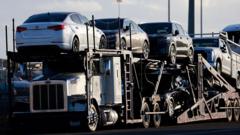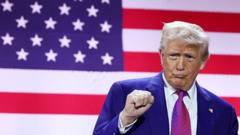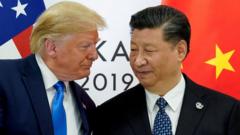A recent shift in US trade policy has introduced a 25% import tariff on critical car components such as engines and transmissions, intensifying pressures on an automotive industry already grappling with a series of policy amendments. This new tariff comes shortly after former President Donald Trump had eased such measures in response to industry concerns, albeit not completely eliminating them. The administration asserts that these tariffs aim to incentivize car manufacturers to boost domestic production. However, analysts predict that any immediate increase in US manufacturing is likely to result in a decline in production in other countries, alongside escalated operational costs that may translate into higher prices for consumers.
New Tariffs on Car Parts Pressure US Automobile Industry

New Tariffs on Car Parts Pressure US Automobile Industry
The introduction of a new 25% tariff on car parts is reshaping the US automobile landscape, heightening costs and uncertainties.
For now, a sales spike has allowed companies to sidestep immediate impacts; both General Motors and Ford reported significant sales growth in April. Still, GM has forecasted a potential $5 billion increase in costs this year due to the tariffs, with about $2 billion expected from charges concerning vehicles produced in South Korea for the US market. Consequently, automakers are revising price projections upward, with an estimated rise of 1% rather than the initial predictions of price reductions.
The unforeseen fluctuations have prompted several auto manufacturers, including Stellantis—the company behind Jeep, Fiat, and Chrysler—to retract financial forecasts due to the current unpredictability. Stellantis' CFO articulated the pressing uncertainties directly affecting firm strategies. Considering that nearly 50% of vehicles sold in the US last year were imported, Trump's announcement on imposing tariffs sent shockwaves through the industry, provoking apprehensions regarding cost inflation and potential repercussions on production levels.
In a bid to stabilize operations, the administration has allowed exemptions for parts manufactured in Mexico and Canada under long-standing free trade agreements. Such revisions were initially described as temporary but are now expected to be enduring measures after recent customs guidelines emerged. Moreover, Trump introduced new policies that protect firms from incurring multiple tariffs for identical goods while implementing a two-year framework for carmakers to minimize tariffs on imported parts used in domestically assembled vehicles.
Although companies like General Motors and Mercedes-Benz are considering strategies to offset these cost increases—such as expanding production in the US—it is clear that building new factories is unlikely in the current volatile environment. According to labor studies expert Art Wheaton, significant investments would be hesitated given the rapid shifts within the market. He states that the real economic impacts of these tariffs have yet to be fully realized, adding to the uncertainty as the administration explores potential trade agreements with pivotal partners, including South Korea and Japan. The long-term ramifications of these emerging tariffs remain uncertain as the industry continues to navigate this complex landscape.
The unforeseen fluctuations have prompted several auto manufacturers, including Stellantis—the company behind Jeep, Fiat, and Chrysler—to retract financial forecasts due to the current unpredictability. Stellantis' CFO articulated the pressing uncertainties directly affecting firm strategies. Considering that nearly 50% of vehicles sold in the US last year were imported, Trump's announcement on imposing tariffs sent shockwaves through the industry, provoking apprehensions regarding cost inflation and potential repercussions on production levels.
In a bid to stabilize operations, the administration has allowed exemptions for parts manufactured in Mexico and Canada under long-standing free trade agreements. Such revisions were initially described as temporary but are now expected to be enduring measures after recent customs guidelines emerged. Moreover, Trump introduced new policies that protect firms from incurring multiple tariffs for identical goods while implementing a two-year framework for carmakers to minimize tariffs on imported parts used in domestically assembled vehicles.
Although companies like General Motors and Mercedes-Benz are considering strategies to offset these cost increases—such as expanding production in the US—it is clear that building new factories is unlikely in the current volatile environment. According to labor studies expert Art Wheaton, significant investments would be hesitated given the rapid shifts within the market. He states that the real economic impacts of these tariffs have yet to be fully realized, adding to the uncertainty as the administration explores potential trade agreements with pivotal partners, including South Korea and Japan. The long-term ramifications of these emerging tariffs remain uncertain as the industry continues to navigate this complex landscape.






















